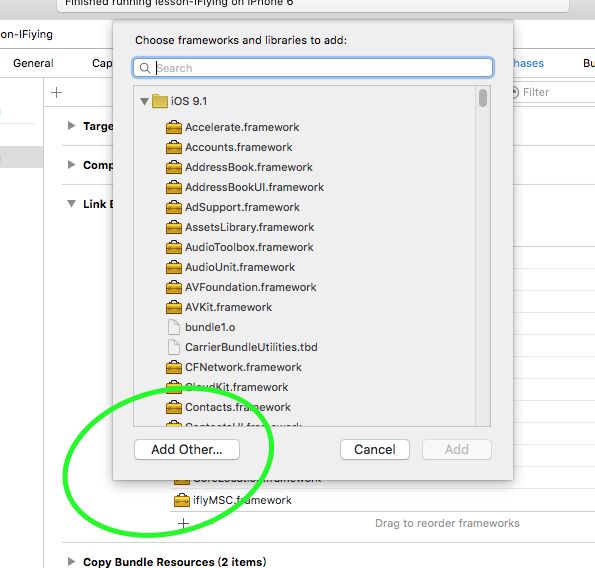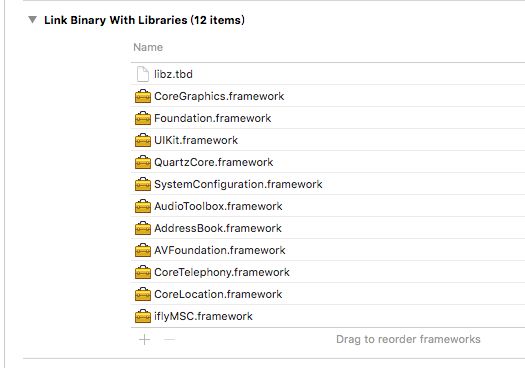简单叙述语音听写;
语音听写就是将一段语音转换成文字内容,能识别常见的词汇,语句,语气并自动断句.
- 1,创建 iOS 工程
创建一个新的工程,或者已经打开已经建立的工程. - 2,添加静态库
将在开发工具包中 lib 目录下的 iflyMSC.framework 添加到新的工程中.
在工程的build Phases下的添加
- 3,添加framework
按下图添加 SDK 所需要的 iOS 库,请注意 libz.tbd,CoreTelephoney.framework 不要遗漏.
- 4,导入头文件
//语音识别相关
#import
#import
#import
RootViewController.m
//声明一个IFlyRecognizerViewDelegate协议.这是为识别会话的服务代理
@interface RootViewController ()
//声明一个IFlyRecognizerView的属性.
@property (nonatomic, strong) IFlyRecognizerView *recognizerView;//讯飞提供的语音识别界面
@end
//在viewDidLoad里
- (void)viewDidLoad {
[super viewDidLoad];
/**
* Appid: 5722b9a5
*/
self.navigationItem.title = @"语音的合成";
//设置代理,
self.recognizerView.delegate = self;
//设置的是当前主要的功能 iat:将语音转化为普通文本.
[self.recognizerView setParameter:@"iat" forKey:[IFlySpeechConstant IFLY_DOMAIN]];
//设置的是语音存储位置 语音默认保存位置
[self.recognizerView setParameter:@"asrview.pcm" forKey:[IFlySpeechConstant ASR_AUDIO_PATH]];
//在未启动语音识别功能时,先隐藏界面.
self.recognizerView.hidden = YES;
//启动按钮(添加按钮,在点击按钮时,调用方法)
UIButton *button = [UIButton buttonWithType:UIButtonTypeSystem];
[button setFrame:CGRectMake(100,100, 100, 50)];
[button setTitle:@"启动听写" forState: UIControlStateNormal];
[button addTarget:self action:@selector(startRecoder:) forControlEvents:UIControlEventTouchUpInside];
[self.view addSubview:button];
//初始化 testView, 用来显示识别好的文字
UITextView *textView = [[UITextView alloc] initWithFrame:CGRectMake(50, 250, 250, 250)];
textView.backgroundColor = [UIColor grayColor];
[self.view addSubview:textView];
textView.tag = 1000;//提供表示符.
}
语音听写的代理方法
//语音转化为文字完成的时候,执行的方法
- (void)onResult:(NSArray *)resultArray isLast:(BOOL)isLast{
NSLog(@"isLast:%d-----resultArray:%@",isLast,resultArray);
//1,先将 resultArray 的第一个元素取出(字典类型)
NSDictionary *dic = resultArray[0];
//2,由于有用的信息在 dic 的 key 值中,所以我们一会要取出 key 值.
NSString *jsonResult = [dic allKeys].lastObject;
//3,解析 jsonresult, 取出语音转换好的文字
NSString *resultString = [self transFromWithSouceString:jsonResult];
//将文字呈现在 testView 上
UITextView *textView = [self.view viewWithTag:1000];
if (textView.text) { //说明 textView 上已经有文字,那就直接拼接.
textView.text = [NSString stringWithFormat:@"%@%@",textView.text,resultString];
}else{//无文字,直接赋值
textView.text = resultString;
}
//取消\结束转换
[self.recognizerView cancel];
}
//语音转换为文字出错地方的代理方法
- (void)onError:(IFlySpeechError *)error{
NSLog(@"出错了:%@",error.errorDesc);
}
将语音转换好的文字提取出来,显示在 textView上
//例如将以下文字的内容输出'' 今天的天气怎么样.'' {"sn":1,"ls":true,"bg":0,"ed":0,"ws":[{"bg":0,"cw":[{"w":" 今天 ","sc":0}]},{"bg":0,"cw":[{"w":" 的","sc":0}]},{"bg":0,"cw":[{"w":" 天气 ","sc":0}]},{"bg":0,"cw":[{"w":" 怎么样 ","sc":0}]},{"bg":0,"cw":[{"w":" 。","sc":0}]}]}
- (NSString*)transFromWithSouceString:(NSString*)sourceString{
if (sourceString == nil) { //如果 sourceString 不存在,就不进行数据处理.
return @"";
}
//1.将 json 串转换为需要的字典类型.
/**
现将字符串转换为 NSData 类型
*/
NSData *dataSource= [sourceString dataUsingEncoding:NSUTF8StringEncoding];
//万一崩溃,先检查 source 是否有值
//将data 解析为字典
NSDictionary *dic = [NSJSONSerialization JSONObjectWithData:dataSource options:NSJSONReadingAllowFragments error:nil];
//先取出'ws'对应的值,
NSArray *wsArray = [dic objectForKey:@"ws"];
//声明一个可变字符串,用来拼接可变字符
NSMutableString *resultString = [[NSMutableString alloc] init];
//遍历wsArray,取出该数组当中的所有元素(字典)
for (NSDictionary *itemDic in wsArray) {
//itemDic 的数据结构->{"bg":0,"cw":[{"w":" 今天 ","sc":0}]}
/**
* 将 itemDic 当中的 cw的值取出,该值得类型为数组.
*/
NSArray *cwarray = [itemDic objectForKey:@"cw"];
//遍历 cwarray,取出该数组当中的所有元素(字典);
for (NSDictionary *cwdic in cwarray) {
//cwdic 的数据结构为{"w":" 今天 ","sc":0}
//1,先将 w 所对应的值取出
NSString *wString = cwdic[@"w"];
//将 w 的值拼接起来.拼接到 resultString 中
[resultString appendString:wString];
}
}
//将最终的字符返回
return resultString;
}
给recognizerView写一个懒加载
#pragma mark-----懒加载
- (IFlyRecognizerView *)recognizerView{
if (!_recognizerView) {
_recognizerView = [[IFlyRecognizerView alloc] initWithCenter:self.view.center];
[self.view addSubview:_recognizerView];
}
return _recognizerView;
}
button 的回调按钮的方法,在点击按钮时,开启语音识别服务.
#pragma mark-----回调按钮.
- (void)startRecoder:(UIButton*)sender{
//启动识别服务
[self.recognizerView start];
//让隐藏的界面展现出来
self.recognizerView.hidden = NO;
}




